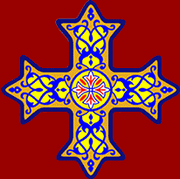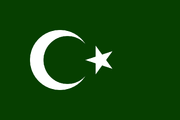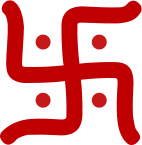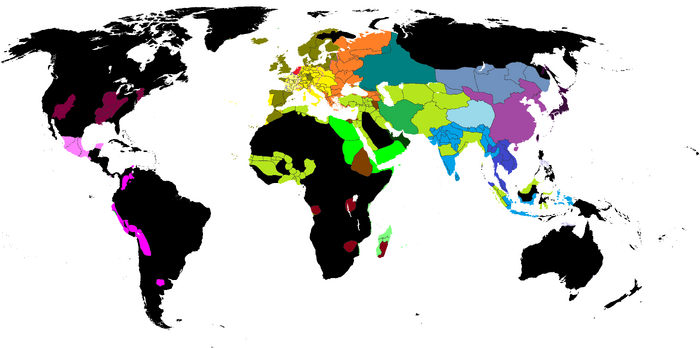Culture can largely be defined by religion. Therefore, understanding of any geopolitical situations relies on understanding of religion.
This page aims to describe major religions of the Principia Moderni III universe, as well as elaborating notable trends and changes that differ from OTL.
World Map[]
- Roman Catholicism is yellow
- Western Church is brown-yellow
- Dutch Church is red
- Eastern Orthodoxy is orange
- Oriental Orthodox is brown
- Sunni Islam is lime green
- Ibadiyya Islam is darker green
- Shia Islam is darkest green
- Hinduism is blue
- Buddhism is darker blue
- Bon Religion is pale blue
- Mongolian Buddhism is grey-blue
- Confucianism is purple
- Shintoism is violet.
- Mastoravism is teal-blue.
- Other "pagan" religions are shades of pink/red; the Mesoamerican pantheon is light pink, the South American pantheon is hot pink, the North American pantheon is fuchsia, and the African pantheons are all dark pink.
Christianity[]
Christianity is a religion, dominant in Europe, that follows the teachings of Jesus Christ, the Messiah and Son of God. Christians believe that Jesus was the Savior and resurrected after being crucified at the orders of Pontius Pilate and the Sanhedrin.
Since the resurrection of Christ, different religious leaders took different approaches in teaching the Scriptures, leading to a number of Schisms and splits in doctrine between localities.
Since the Document of the Unification of the Churches the Roman Catholic, Eastern Orthodox, Oriental Orthodox, and Western Catholic churches are de jure unified into the Holy Catholic Church. The reason for this church is to bridge some of the divides amongst the various branches of Christianity and to set them all on an equal footing. Despite this, each of the branches still maintains their own Patriarch and affairs separately unless by a joint agreement by the Council of Patriarchs.
Roman Catholicism[]

Papal Seal
Roman Catholicism is a major Christian denomination. The Church is based out of the Vatican City, a vassal of the Kingdom of Italy located in the middle of Rome. The leader is called the Pope and is the Bishop of Rome.
Roman Catholicism is the main religion or the officially accepted religion in the following nations: Portugal, France, Austria (and all of the Holy Roman Empire except for Bavaria and Prussia), Italy, Hungary, and Poland.
Venetian Church[]
Venice has currently established a state church, which at the moment is largely a glorified Catholic sect. This was created in response to increased radicalism amongst common Christians to create a unified response to several attempts by several radicals to take over sections of the Venetian administration. At the moment the church has no differences in belief from standard Roman Catholicism.
Western Church[]
The Western Church currently is the main or official religion in the following nations: Spain, Albion, Bavaria, Prussia, and Scandinavia.
In Livonia, the Western Church dominates the religious spectrum. One of the most important figures in that nation, the Archbishop of Riga, is regularly consulted by the Duke. The importance of the Western Church is not only religious but also develops a communal atmosphere in smaller Livonian villages. The devout faith to the Western Church was passed down via the Kingdom of Prussia.
Eastern Orthodoxy[]
Eastern Orthodoxy is the majority religion in the Roman Empire, Dacia, Russia, and the Caucasus. Headed by the Patriarch of Constantinople, the Eastern Orthodox church plays a decisive influence in the affairs of the Black Sea, Middle East, and the Eastern Mediterranean.
Oriental Orthodoxy[]

Oriental Orthodoxy is a branch of Christianity that refers to Christians who revere the Pope of Alexandria as the leader of the Christian Church. The Oriental (or Coptic) Orthodoxy was also the first church to split from the mainstream church, breaking off at the Council of Chalcedon in 451.
The branch is Miaphysitic, believing that Jesus Christ is one person, both divine and human, in one nature. This
Reformed Church []
A church founded at the pinnacle of the reformation movement started by a Dutch priest during the 1410s. Currently the state religion of the Kingdom of the Netherlands, while there exists a small minority through Western Europe. The reformed church is based on the ideals of Father Johann, and those of other critics of the Vatican and the Roman Catholic Church. Due to its lack of recognition in the Holy See and a series of other beliefs it is considered heretical by a large number of Catholics, though relations have been amiable as of late.
Islam[]
Islam is a religion that originated in the 600s AD in Arabia. It holds that there is one god, Allah, and Allah spoke to the people through a series of prophets, including Abraham, Moses, Jesus, and ultimately Mohammed.

Flag of Islam
Sunni[]
Sunni Islam is the largest form of Islam as far as followers, recognition, and political power goes. The major Muslim state in the Near East (the Ottomans) embrace Sunni Islam as their official state religion. Additionally, the Mamluk Sultanate and the Timurids also followed Sunni Islam.
Sunni Islam was based around recognition of Abu Bakr as the First Caliph and the heir to Mohammed.
Assafi[]
Assafi Islam is a new form of Islam, based out of traditional Sunni Islam, but embracing a more westernized and liberalized form of practice. It has its origins in Yemen, where Saadiq Assaf, the Holy Caliph of Revelation, was born. Assaf fled to Alexandria to teach his ideas, which caught on and inspired republicanism in the Mamluk Sultanate.
Assafi Islam was practiced as the state religion of the Grand Sultanate of the Mashriq, and has an impact in many of the successor states, notably in Yemen which was Assaf's homeland.
Shia[]
Shia Islam is the second largest sect of Islam by followers. Currently only one major nation follows Shia Islam (Safavids), and Shias are a minority around the fertile crescent.
Ibadi[]
The Ibadi sect of Islam is the largest of a variety of minority sects. The Ibadis do not currently control a Muslim state, however a plurality of the citizens of Oman currently practice Ibadi Islam.
Paganistic Islam[]
Paganistic Islam is a sect of Islam that was developed as a result of the so-called "Satanic Verses" which created tension in Muslim communities with their discovery in Mecca in 1456. Paganistic Islam takes various forms in various nations depending upon the traditions of that area. The two main regions in which paganistic Islam had caught on were the Swahili Coast and Madagasikaran states, as well as Medina and Mecca.
The role of Paganistic Islam near Madagasikara was quite valuable as it provided an initial transition from disorganized religion towards more organized religions which would arrive with Spain.
Hinduism[]

Hindu Symbol
Big in India
Buddhism[]
Shinto []
Shinto is a religion found mainly in East Asia which centres around the worship of kami, or, in essence, nature spirits, which reside in all things. Its teachings are enshrined in the Kojiki, while rites happen mainly at shrines. Shinto is most popular in Japan, where it is the religion of most of the population, and in Kamchatka and the Alyeskan Khaganate. Many Shintoists are simultaneously Buddhists or Tengriists, since the religion does not rule out a multiplicity of beliefs.
Imperial Shinto[]
Imperial Shinto emerged as a noteworthy sect in 1463 in the North East of the Date Province, worshiping the Emperor as a semi-divine being. With the Ashikaga civil war (1464-72), the sect quickly grew to greater prominence, exploiting tensions and dissent among the peasantry towards the Shogun's repressive policies and the introduction of tithes. This culminated with the invitation to the Emperor to take control of the situation, ending the civil war and leading to the establishment of the Fusahito Theocracy with Imperial Shinto as the main religion. Unlike regular Shinto beliefs and practices, Imperial Shinto places much emphasis on the role of the Emperor and is more of an all encompassing religion, ruling out a multiplicity of beliefs. As a theocracy, Imperial Japan places a high importance on religion in society, with a strict Shinto hierarchy with the Emperor the head of the religion. With the reforms of 1537, any person in public office, whether the military or bureaucracy, must be a member of the Imperial Shinto sect.
Tuktism[]
Tuktism is the syncretic religion of the Nehilaw, popularized after the Antler War and the defeat of the anti-syncretic elements in the Sachemate. Similar to OTL voodoo, it is the culmination of decades of mutation resulting from close contact between Nehilaw shamanism and Western Christianity, While in theory acknowledging the existence of an omniscient god, Tuktism holds that said God is disinterested in Earth and leaves the running of actual temporal affairs to a confusing array of spirits, who must be placated and sacrificed to. These spirits can also be used to curse one's enemies, advance one's goals, or find love if the proper rituals are used. Certain individuals, called mdawineo and a cross between shamans and priests, can communicate with these spirits and advise people on how to satisfy them. The use of hallucinogenic plants is popular to achieve this. These mdawineo practice both light and dark forms of magic. Many spirits correspond to Christian saints or archangels.
Shamanism[]
Shamanism is a broad term used for a variety of different paganistic religions. The common themes among all shamanistic religions are, however:
- Belief in a spirit world,
- Belief that spirits can be contacted by reaching a state of altered consciousness,
- Role of religious elders, or shamans, in contacting spirits, and the
- Belief that shamans can be possessed by various spirits.
Through these four basic tenets, the ideas of shamanism can be traced to various different time periods in almost all regions of the world. Shamanism was an important part of the following cultures: Indian, Mongolian, Korean, Japanese, Siberian, Northern European, Kelutmiut, Native Borealian and Native Hesperian.
Kelutmiut Shamanism[]
TO BE WRITTEN
Footnotes[]
| ||||||||||||||||||||||||||||||||||||||||||







